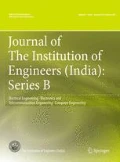Abstract
Electric vehicles are treated as the future of automotive technologies as they help to solve the energy shortage and act as a clean source of energy. The electric vehicle charging station technology has progressed continuously, and it will dominate the load scenario in the near future. The non-linear nature of the loads at charging stations has contributed to the harmonic emissions and impacted the power quality of the distribution system. In this paper, the simulation for harmonics mitigation at charging stations is Developed using MATLAB/Simulink. A non-linear notch filter, viz. enhanced phase-locked loop (EPLL), is used for implementation of active power filter at the charging station. The EPLL-based active filter is used for reference current generation and acts as an excellent frequency domain technique for estimation of harmonics for a non-linear load. The control algorithm is implemented using low-cost target platforms like Arduino and C2000-based Launchpads from Texas Instruments. Moreover, with a single algorithm, it is possible to detect the harmonics as well as synchronize the current injected by active power filter in the power system. Additionally, fuzzy logic controller and sliding mode controllers are used to maintain constant voltage across the DC link of inverter in active power filter. The simulation results show that there is a significant improvement in the current profile, and the total harmonic distortion of the source current meets the IEEE 519 standard.






















Similar content being viewed by others
References
K. Abu-Rub, M. Malinowski, K. Al-Haddad, Power electronics for renewable energy systems, transportation and industrial applications (Wiley, Chichester, 2014)
K.T. Chau, Electric vehicle machines and drives: design, analysis and applications (Wiley, New Jersey, 2015)
B. Allaoua, A. Laoufi, A novel sliding mode fuzzy control based on SVM for electric vehicles propulsion system. Energy Procedia 36, 120–129 (2013)
R.R. Ahrabi, H. Ardi, M. Elmi, A. Ajami, A novel step-up multiinput DC-DC converter for hybrid electric vehicles application. IEEE Trans. Power Electron. 32(5), 3549–3561 (2017)
C.M. Lai, Y.H. Cheng, M.H. Hsieh, Y.C. Lin, Development of a bidirectional DC/DC converter with dual-battery energy storage for hybrid electric vehicle system. IEEE Trans. Veh. Technol. 67(2), 1036–1052 (2018)
S. Bai, S.M. Lukic, Unified active filter and energy storage system for an MW electric vehicle charging station. IEEE Trans. Power Electron. 28(12), 5793–5803 (2013)
T. Na, Q. Zhang, J. Tang, J. Wang, Active power filter for single-phase quasi-z-source integrated on-board charger. CPSS Trans. Power Electron. Appl. 3(3), 197–201 (2018). https://doi.org/10.24295/CPSSTPEA.2018.00019
H.V. Nguyen, D.-Du. To, D.C. Lee, Onboard battery chargers for plug-in electric vehicles with dual functional circuit for low-voltage battery charging and active power decoupling. IEEE Access 6, 70212–70222 (2018). https://doi.org/10.1109/ACCESS.2018.2876645
M. Karimi-Ghartemani, M.R. Iravani, A nonlinear adaptive filter for online signal analysis in power systems: applications. IEEE Trans. Power Deliv. 17(2), 617–622 (2002)
M. Karimi-Ghartemani, H. Mokhtari, M.R. Iravani, M. Sedighy, A signal processing system for extraction of harmonics and reactive current of single-phase systems. IEEE Trans. Power Deliv. 19(3), 979–986 (2004)
S. Karvekar and D. Patil, “A novel technique for implementation of shunt active power filter under balanced and unbalanced load conditions.” In: 2013 International conference on circuits, power and computing technologies (ICCPCT), Nagercoil, 2013, pp. 1–5
B. Singh, K. Al-Haddad, A. Chandra, A review of active filters for power quality improvement. IEEE Trans. Industr. Electron. 46(5), 960–971 (1999)
C. V. Suru, M. Popescu, M. Linca and A. Stanculescu, “Fuzzy Logic Controller Implementation for the Compensating Capacitor Voltage of an Indirect Current Controlled Active Filter.”In: 2020 International Conference and Exposition on Electrical and Power Engineering (EPE), Iasi, Romania (2020)
V. R. Metha and S. S. Karvekar, "Speed Control of Induction Motor using A Fuzzy Logic Controller and Direct Torque Controller.” In: 2018 4th International Conference for Convergence in Technology (I2CT), Mangalore, India, 2018
S. Karvekar, S Patil, A M Mulla,D Patil , "Goertzel Algorithm Based Shunt Active Power Filter Using Sliding Mode Controller", Proceedings of the World Congress on Engineering and Computer Science 2014 Vol I WCECS 2014, 22–24, 2014, San Francisco, USA
V. Utkin, J.G.J. Shi, Sliding mode control in electro-mechanical systems (CRC Press, Boca Raton, 2009)
J.Y. Hung, W. Gao, J.C. Hung, Variable structure control: a survey. Indust. Elect. IEEE Trans. 40(1), 2–22 (1993)
Author information
Authors and Affiliations
Corresponding author
Additional information
Publisher's Note
Springer Nature remains neutral with regard to jurisdictional claims in published maps and institutional affiliations.
Rights and permissions
Springer Nature or its licensor holds exclusive rights to this article under a publishing agreement with the author(s) or other rightsholder(s); author self-archiving of the accepted manuscript version of this article is solely governed by the terms of such publishing agreement and applicable law.
About this article
Cite this article
Karvekar, S., Joshi, P. Implementation of EPLL-Based Control Algorithms using Low-Cost Target Platforms for Synchronization in Electrified Transportation Systems. J. Inst. Eng. India Ser. B 103, 1961–1973 (2022). https://doi.org/10.1007/s40031-022-00791-x
Received:
Accepted:
Published:
Issue Date:
DOI: https://doi.org/10.1007/s40031-022-00791-x




